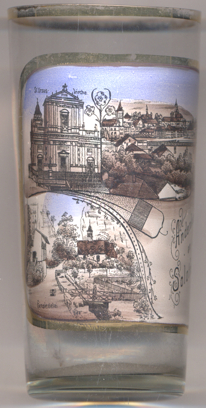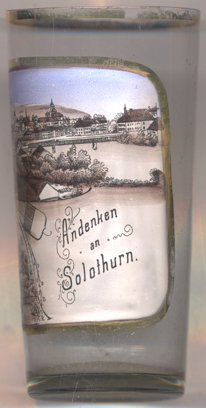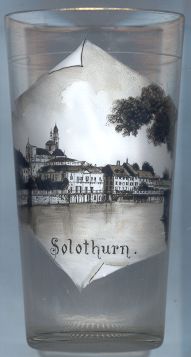

|
| SCHWEIZ / SUISSE / SVIZZERA / SVIZRA | SWITZERLAND |
| Solothurn / Soleure / Soletta / Soloturn |
Solothurn is situated at an elevation of 439 m on the river Aare in the southern foothills of the Jura mountains of northwestern Switzerland. Solothurn is the capital of the canton of the same name and has a population of about 15,100 (2004).
The Celtic Salodurum was founded between AD 14 and 37 during the reign of the roman emperor Tiberius. According to the legend, two soldiers of the ‘Theban Legion’, Ursus and Victor, in 303 died as martyrs in this place. They are today venerated as the patron saints of Solothurn. The St. Ursenstift monastery was founded in 932 by Queen Bertha of Burgundy. Around 1033 Solothurn obtained the status of a town, and in 1218 it became a Free Imperial City. In 1481 Solothurn joined the Old Swiss Confederacy. During the Reformation, 1523–1533, Solothurn remained Catholic. Since 1530 the city was the residence of the French Ambassadors to Switzerland who kept their residence here until 1792. One of the sobriquets of Solothurn thus became ‘the Ambassador City’. The Catholic bishops of Basel had moved their residence to Porrentruy (Pruntrut) in 1527/1529 after Basel had joined the Reformation. They remained in Porrentruy until 1828 when they finally moved the seat of the diocese to Solothurn.


The  cathedral of St. Ursus [left, no. 3123: top left]
is the seat of the Catholic bishops of Basel. The church goes back to the monastery that had been founded in 870 AD.
When the tower of the prior church had collapsed in 1762, the architect Gaetano Matteo Pisoni from Ascona was charged with
the construction of a new church. The construction of the Classicist church began in 1762 and was completed by his nephew
Paolo Antonio Pisani in 1773. The church at that time served as church of the canons’ monastery and as parish church.
In 1828 it became the new seat of the bishops of Basel.
cathedral of St. Ursus [left, no. 3123: top left]
is the seat of the Catholic bishops of Basel. The church goes back to the monastery that had been founded in 870 AD.
When the tower of the prior church had collapsed in 1762, the architect Gaetano Matteo Pisoni from Ascona was charged with
the construction of a new church. The construction of the Classicist church began in 1762 and was completed by his nephew
Paolo Antonio Pisani in 1773. The church at that time served as church of the canons’ monastery and as parish church.
In 1828 it became the new seat of the bishops of Basel.
The  Verena Hermitage [left, no. 3123: bottom left]
is located in the Verena Gorge, to the north of the city. The name of the hermitage alludes to Saint Verena. She is
said to have passed near the area, and lived in a cave near Solothurn.
On the left: Chapel of St. Verena; on the right: Chapel of St. Martin.
One of the chapels goes back to the 12th century and thus is the second-oldest edifice in Solothurn.
The oldest document mentioning the place ze sant Frenen as a hermitage dates from 1442.
Towards the end of the 18th century, the place in he gorge was developed into a romantic landscape park.
The site als features stations of the cross dating from 1613 that were restored around 1990 by the The Society
of St. Verena Hermitage. The Society was founded in 1810 and disbanded in 1813. A similar corporation was established in
the late 20th Century dedicated to restoration and maintenance work on the buildings and monuments of the Hermitage and
its surroundings. It organizes cultural events such as guided tours, lectures and exhibitions in the Verena gorge, also
offering meditations in the hermitage. The subsistence of the hermite is traditionally paid by the city of Solothurn.
Verena Hermitage [left, no. 3123: bottom left]
is located in the Verena Gorge, to the north of the city. The name of the hermitage alludes to Saint Verena. She is
said to have passed near the area, and lived in a cave near Solothurn.
On the left: Chapel of St. Verena; on the right: Chapel of St. Martin.
One of the chapels goes back to the 12th century and thus is the second-oldest edifice in Solothurn.
The oldest document mentioning the place ze sant Frenen as a hermitage dates from 1442.
Towards the end of the 18th century, the place in he gorge was developed into a romantic landscape park.
The site als features stations of the cross dating from 1613 that were restored around 1990 by the The Society
of St. Verena Hermitage. The Society was founded in 1810 and disbanded in 1813. A similar corporation was established in
the late 20th Century dedicated to restoration and maintenance work on the buildings and monuments of the Hermitage and
its surroundings. It organizes cultural events such as guided tours, lectures and exhibitions in the Verena gorge, also
offering meditations in the hermitage. The subsistence of the hermite is traditionally paid by the city of Solothurn.
[https://en.wikipedia.org/wiki/Verena_Gorge_Hermitage, https://de.wikipedia.org/wiki/Einsiedelei_Sankt_Verena]

The  Palais Besenval [near left, no. 2059: foreground left]
on the bank of the river Aare was built in 1701–1706 for the mayor Johann Viktor Besenval. The building was
designed by a French architect in the style of French hôtels privés.
Palais Besenval [near left, no. 2059: foreground left]
on the bank of the river Aare was built in 1701–1706 for the mayor Johann Viktor Besenval. The building was
designed by a French architect in the style of French hôtels privés.
In 1980 the city of Solothurn was awarded the Wakker Prize of the Swiss Heritage Society for the development and
preservation of its architectural heritage.
Other cities that have been awarded this prize and which are depicted on glasses of this collection are:
Altdorf (2007),
Baden (2020),
Basel (1996),
Bern (1997),
Biel/Bienne (2004),
Genève (2000),
La Chaux-de-Fonds (2011),
Lausanne West (Bussigny-près-Lausanne, Chavannes-près-Renens, Crissier, Ecublens, Lausanne, Prilly, Renens, Saint-Sulpice, Villars-Sainte-Croix) (2011),
Montreux (1990),
Sankt Gallen (1992),
Stein am Rhein (1972),
Wil (1984),
Winterthur (1989).
![[scale]](lineal.jpg)